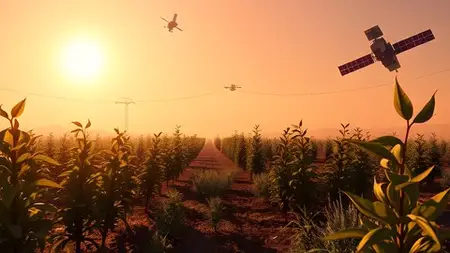Crop Failure Mapping Using Remote Sensing And Gee
Published 8/2025
MP4 | Video: h264, 1920x1080 | Audio: AAC, 44.1 KHz
Language: English | Size: 457.07 MB | Duration: 1h 0m
Published 8/2025
MP4 | Video: h264, 1920x1080 | Audio: AAC, 44.1 KHz
Language: English | Size: 457.07 MB | Duration: 1h 0m
Learn how to detect and map crop failure risk using NDVI and rainfall data in Google Earth Engine for agriculture
What you'll learn
Learn to calculate and analyze NDVI from satellite imagery for monitoring vegetation health and detecting stress in crops over time.
Process and interpret rainfall data using remote sensing to understand precipitation patterns and their impact on agriculture.
Develop comprehensive crop failure risk maps in Google Earth Engine by integrating vegetation and rainfall anomalies for proactive agricultural management.
Export and utilize geospatial datasets effectively for informed decision-making, agricultural planning, and risk mitigation strategies.
Requirements
No prior experience with Google Earth Engine is required — the course will guide you step-by-step.
Description
Crop failures due to drought, extreme weather, or land degradation have serious impacts on food security and livelihoods. In this course, you’ll learn how to monitor and map crop failure risks using remote sensing techniques and the cloud-based platform Google Earth Engine (GEE).We begin with an introduction to vegetation monitoring using NDVI (Normalized Difference Vegetation Index) from Sentinel-2 imagery, and rainfall trends using CHIRPS daily precipitation datasets. You’ll understand how to extract seasonal NDVI and rainfall data, compute long-term averages, and calculate anomalies for the current season.The course guides you through creating a crop risk index by combining vegetation health and rainfall deviation. You'll learn data normalization, risk index computation, and apply thresholds to identify high-risk agricultural zones. The final outputs include visually intuitive maps that highlight areas with significant crop stress.Each step is carefully explained with working GEE JavaScript code, so you can follow along—even with little prior coding experience. You'll also learn how to export your maps as GeoTIFFs, making them suitable for GIS integration and policy reports.Whether you're a student, researcher, or practitioner in agriculture or environmental science, this course equips you with the tools to build real-world risk mapping solutions. By the end, you’ll be confident in building your own crop failure monitoring systems using open data and GEE.
Overview
Section 1: Introduction
Lecture 1 Lecture 1: Fundamentals of Remote Sensing
Lecture 2 Lecture 2: Remote Sensing for Risk Mapping
Lecture 3 Lecture 3: Sentinel-2 Satellite and Spectral Bands
Lecture 4 Lecture 4: Introduction to Google Earth Engine (GEE)
Lecture 5 Getting Started with the Google Earth Engine Interface
Lecture 6 Lecture 5: Implementing Crop Failure Mapping in GEE Using Sentinel-2
Students, researchers and professionals in agriculture, environmental science, geography, or remote sensing looking to apply satellite data in real-world scenarios.



